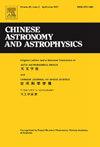Orbit Accuracy Simulation Analysis of Asteroid (469219) Kamoòalewa by Optical Observation of Tianwen-2
Q4 Physics and Astronomy
引用次数: 0
Abstract
China’s asteroid exploration mission, Tianwen-2, is scheduled to launch in 2025. Its first target, asteroid (469219) Kamoòalewa (also known as 2016 HO3), is a near-Earth object in co-orbit with Earth, with significant research value in terms of its motion evolution. Currently, there are limited ground observation data available for asteroid (469219) Kamoòalewa, which restricts its orbit accuracy. Tianwen-2, equipped with an optical payload, is expected to acquire a large amount of onboard optical observation data during its approach to Kamoòalewa. This will greatly improve the study situation of asteroid (469219) Kamoòalewa, which currently has only ground-based optical observation data and lacks publicly available observation data after 2021. By simulating the optical observation data of Tianwen-2 with a spacecraft orbit error of 2 km, the pre-mission evaluation of the orbit prediction accuracy of asteroid (469219) Kamoòalewa has been completed. The precision evaluation was performed using covariance analysis and numerical comparison methods. Within the possible range of observation precision considered in this study, it is estimated that the optical observation data from Tianwen-2 can improve the overall orbit accuracy of asteroid (469219) Kamoòalewa to better than 15 km. Additionally, an analysis was conducted to examine the differences and characteristics of the results obtained from the two precision evaluation methods.
天文二号光学观测小行星(469219)Kamoòalewa轨道精度模拟分析
中国的小行星探测任务“天文二号”计划于2025年发射。它的第一个目标小行星(469219)Kamoòalewa(也称为2016 HO3)是一颗与地球共轨运行的近地天体,在其运动演变方面具有重要的研究价值。目前,小行星(469219)Kamoòalewa的地面观测数据有限,限制了其轨道精度。配备光学有效载荷的天文2号预计将在接近Kamoòalewa期间获取大量机载光学观测数据。这将大大改善小行星(469219)Kamoòalewa目前只有地面光学观测数据,缺乏2021年后公开观测数据的研究状况。利用轨道误差为2 km的“天文二号”卫星光学观测数据,对小行星(469219)Kamoòalewa的轨道预测精度进行了任务前评估。采用协方差分析和数值比较法进行精度评价。在本研究考虑的可能观测精度范围内,估计天文二号的光学观测数据可以将小行星(469219)Kamoòalewa的整体轨道精度提高到15 km以上。此外,还分析了两种精度评价方法所得结果的差异和特点。
本文章由计算机程序翻译,如有差异,请以英文原文为准。
求助全文
约1分钟内获得全文
求助全文
来源期刊

Chinese Astronomy and Astrophysics
Physics and Astronomy-Astronomy and Astrophysics
CiteScore
0.70
自引率
0.00%
发文量
20
期刊介绍:
The vigorous growth of astronomical and astrophysical science in China led to an increase in papers on astrophysics which Acta Astronomica Sinica could no longer absorb. Translations of papers from two new journals the Chinese Journal of Space Science and Acta Astrophysica Sinica are added to the translation of Acta Astronomica Sinica to form the new journal Chinese Astronomy and Astrophysics. Chinese Astronomy and Astrophysics brings English translations of notable articles to astronomers and astrophysicists outside China.
 求助内容:
求助内容: 应助结果提醒方式:
应助结果提醒方式:


